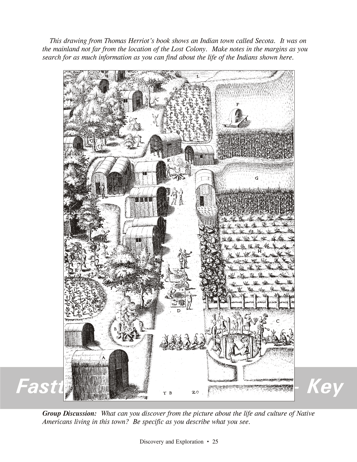| Fasttrack
to America's Past Teacher Key |
|
| Fasttrack
to America's Past Teacher Key |
|
 Page 24  Page 25 |
Pages 24
& 25 - The English Meet the Native Americans The reading selection, page 24 This is one of the earliest accounts of Native American life and culture written by an Englishman. Before reading it aloud or assigning it to students to read on their own, be sure to scan the text for any words your students may not know. (For example, in the last paragraph, "burning glasses" is a reference to magnifying glasses. The sun can be focused with a magnifying lens on wood or paper to start a fire.) The small picture of the Indian is from Thomas Harriot's book. It shows one of the chiefs of the Indians living near the English settlement on Roanoke Island. A good strategy
for developing reading skills is to read
the selection aloud as a class, then examine the questions
briefly.
Have students read the text again on their own, now using a highlighter
or red pencil to mark lines that would help answer the questions. Group Discussion questions The Group Discussion questions on page 24 ask students to examine differences and similarities between Native American and European culture around 1500. Some similarities: Both had towns, a government system, leaders, and the need for defense. Both had religious beliefs, with stories about the creation, and both represented divinities with images in human form. Some differences: The Native Americans had not developed the use of iron for tools or weapons. They did not usually fight large set battles as Europeans did. Their religion had many gods, not one, and their creation story has a woman as the first human, rather than a man. Indians had not developed technology as much as Europeans had. In spite of these differences, Thomas Harriot describes the Indians as "very ingenious" and having "excellence of wit" in their skills.The Indian village, page 25 The large image of the Indian Village of Secota gives students a chance to do first hand analysis of a primary source historical document. The page asks students to examine the drawing, and find as much as they can about the life of the Indians shown.
Students should be taught to look first at the overall image.
What
does it show? Next, tell students to look carefully at each part
of the image, and try to tell what exactly is being shown. Have
them
jot short notes in the margins Students will
discover for themselves that a historical
image can be a source of many clues to many aspects of a culture they
are
trying to understand.
After students have time to study the picture and make notes in the margins, lead a class discussion of what they found. Be sure to distinguish between things that are factual and visible (the corn plants and houses) and statements that are possible, but not certain. For example, the Indians dancing in a circle of poles may be worshiping in a religious rite, but we would need more evidence to be certain of this. After finishing this page, you may want to assign students a short library project researching the life and culture of other Indian groups of that time, such as the Creeks or Iroquois. This would be a good time to familiarize students will basic library and Internet resources on Native Americans. |
|
Copyright Notice
Copyright 2018 by David Burns. All rights reserved. Illustrations and reading selections appearing in this work are taken from sources in the public domain and from private collections used by permission. Sources include: the Dover Pictorial Archive, the Library of Congress, The National Archives, The Hart Publishing Co., Corel Corporation and its licensors, Nova Development Corporation and its licensors, and others. Maps were created or adapted by the author using reference maps from the United States Geological Survey and Cartesia Software. Please see the home page for this title for more information. |